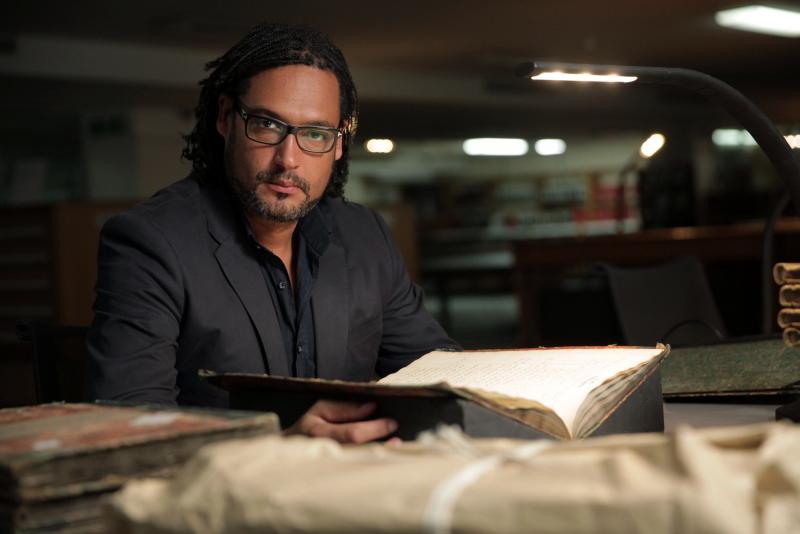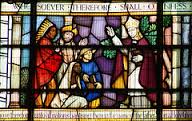Britain's Forgotten Slave Owners, BBC Two | reviews, news & interviews
Britain's Forgotten Slave Owners, BBC Two
Britain's Forgotten Slave Owners, BBC Two
Archive revelations revise our understanding of the reality of the institution

If Britain has created a national myth about slavery, it’s surely been centred on the pioneering abolitionists whose actions in the early 19th century led first to the ending of the slave trade across the British Empire in 1807, later to the abolition of the institution in 1834. It’s a record of which, compared to the approach of other nations to the same issue (and the speed of their actions), we may even feel a hint of pride.
It’s a myth that BBC Two’s Britain's Forgotten Slave Owners put deservedly to rest, confronting us with harsh facts of history that have been conveniently forgotten. How many of us would have known, until we watched this programme, that when the House of Commons passed its 1834 bill, it was accompanied by paying huge compensation to slave-owners, to the tune of £17 billion in today’s money? The slaves themselves received not a penny. That wasn’t the only concession achieved by the influential slavery lobby: such freedom didn’t even come immediately, rather slaves had to serve their former masters gratis for up to six more years.
Ledger after ledger record in immaculate copperplate the exact identities of the owners
At least we now know exactly who those slave-owners were. Historian David Olusoga presented this two-parter in conjunction with, and based on an ongoing project of University College London (UCL), which has been researching material held at the National Archive at Kew. Ledger after ledger there record in immaculate copperplate the exact identities of the owners (based on the claims they submitted), as well as those of their slaves, no less detailed in their listings of age, occupation, state of health and the like. It’s the kind of detailed source that really does revise our understanding, surprising only in the fact that it seems to have escaped academic attention for almost two centuries.
We first saw Olusoga pacing the streets of central London, revealing exactly which addresses had been the home of slave-owners, and the number of slaves recorded to each of them. The UCL project has mapped Britain in the same way, and ownership went far beyond the places you might expect – the port cities of Bristol, Liverpool and London – to almost every area of the country. It was the identities that were revelatory, spreading far wider than those who had actually had any direct exposure to the realities of slavery in the Caribbean – from aristocrats with whole plantations to widows who had inherited a handful of slaves, from merchants who knew the reality of the trade to priests, whom we might have hoped would have had a different perspective. Only 3,000 of the recorded owners were based in England, out of a total of 46,000 around the empire, but they owned half the slaves.
 There were lots of numbers cited here, developing the programme’s basic thesis that people were property. Olusoga’s wider narrative was of how that awareness entered, and has remained in the history and consciousness of our society. In this first part, titled “Profit and Loss”, he took us through the backstory and some locations, his personal reflections interspersed with brief interviews with some of those involved in the UCL project, as well as experts on Caribbean history, and even descendants of slave-owners. His generally dispassionate tone broke only once, when he was being shown the instruments of restraint – torture might just be too laden a word, but the distinction is surely academic – that discouraged slaves from escape or resistance. (Archivist Lauris Codling at the Institute of Jamaica shows a variety of slave shackles and instruments of punishment, pictured above by Ben Crichton.)
There were lots of numbers cited here, developing the programme’s basic thesis that people were property. Olusoga’s wider narrative was of how that awareness entered, and has remained in the history and consciousness of our society. In this first part, titled “Profit and Loss”, he took us through the backstory and some locations, his personal reflections interspersed with brief interviews with some of those involved in the UCL project, as well as experts on Caribbean history, and even descendants of slave-owners. His generally dispassionate tone broke only once, when he was being shown the instruments of restraint – torture might just be too laden a word, but the distinction is surely academic – that discouraged slaves from escape or resistance. (Archivist Lauris Codling at the Institute of Jamaica shows a variety of slave shackles and instruments of punishment, pictured above by Ben Crichton.)
We learned more of some of the individuals involved. Slave-owner Thomas Thistlewood wrote 90 volumes of diaries which include regular recitations of slit noses, branding and hanging as punishment, and “recipes” for causing pain to recaptured slaves; even by the standards of his contemporaries Thistlewood’s immorality stood out – over 37 years, he recorded some 4,000 sexual encounters, many of them rapes. The mixed-race offspring of such unions were plentiful, but far fewer those who were recognised by their white fathers, from whom they duly inherited, like Nathaniel Wells; sent to England at the age of nine, he duly became a respected country gentleman, even a magistrate. The paradox was that he was “too black and too rich” for his native St Kitts, where he would have been on the other side of justice. With a moderation that didn’t rock society’s boat, we were told that Wells freed some of his relations on his mother’s side.
 Next week’s episode “The Price of Freedom” brings home the financial realities, and how the repercussions of slavery stretched right across the economy of its time. After compensation was paid, it duly filtered down in investment in the fields that proved crucial for Britain’s 19th-century development, not least the railways.
Next week’s episode “The Price of Freedom” brings home the financial realities, and how the repercussions of slavery stretched right across the economy of its time. After compensation was paid, it duly filtered down in investment in the fields that proved crucial for Britain’s 19th-century development, not least the railways.
The individual ironies of history were as rich as some of those involved became: the man who received the biggest sum in compensation was James Gladstone, father of the liberal prime-minister William, no less. William Wilberforce, the undisputed hero of abolitionism, worshipped at the same Clapham church, Holy Trinity (stained glass window telling the abolitionism story there, pictured above), as George Hibbert, the prominent slave-owner who orchestrated the slavery lobby’s attempts to ensure compensation with tactics that come straight out of today’s PR industry (that more recent phrase "too big to fail" also cropped up revealingly here). Full plaudits to director James Van Der Pool for striking a convincing balance between social and economic history, and not losing us when the latter increasingly came to dominate. Olusoga’s tone might occasionally seem to have understated his subject, but that restraint actually allowed the facts to speak more deeply. Britain's Forgotten Slave Owners was a salutary watch in every respect.
rating
Share this article
Add comment
The future of Arts Journalism
You can stop theartsdesk.com closing!
We urgently need financing to survive. Our fundraising drive has thus far raised £49,000 but we need to reach £100,000 or we will be forced to close. Please contribute here: https://gofund.me/c3f6033d
And if you can forward this information to anyone who might assist, we’d be grateful.

Subscribe to theartsdesk.com
Thank you for continuing to read our work on theartsdesk.com. For unlimited access to every article in its entirety, including our archive of more than 15,000 pieces, we're asking for £5 per month or £40 per year. We feel it's a very good deal, and hope you do too.
To take a subscription now simply click here.
And if you're looking for that extra gift for a friend or family member, why not treat them to a theartsdesk.com gift subscription?
more TV
 Mr Scorsese, Apple TV review - perfectly pitched documentary series with fascinating insights
Rebecca Miller musters a stellar roster of articulate talking heads for this thorough portrait
Mr Scorsese, Apple TV review - perfectly pitched documentary series with fascinating insights
Rebecca Miller musters a stellar roster of articulate talking heads for this thorough portrait
 Down Cemetery Road, Apple TV review - wit, grit and a twisty plot, plus Emma Thompson on top form
Mick Herron's female private investigator gets a stellar adaptation
Down Cemetery Road, Apple TV review - wit, grit and a twisty plot, plus Emma Thompson on top form
Mick Herron's female private investigator gets a stellar adaptation
 theartsdesk Q&A: director Stefano Sollima on the relevance of true crime story 'The Monster of Florence'
The director of hit TV series 'Gomorrah' examines another dark dimension of Italian culture
theartsdesk Q&A: director Stefano Sollima on the relevance of true crime story 'The Monster of Florence'
The director of hit TV series 'Gomorrah' examines another dark dimension of Italian culture
 The Monster of Florence, Netflix review - dramatisation of notorious Italian serial killer mystery
Director Stefano Sollima's four-parter makes gruelling viewing
The Monster of Florence, Netflix review - dramatisation of notorious Italian serial killer mystery
Director Stefano Sollima's four-parter makes gruelling viewing
 The Diplomat, Season 3, Netflix review - Ambassador Kate Wyler becomes America's Second Lady
Soapy transatlantic political drama keeps the Special Relationship alive
The Diplomat, Season 3, Netflix review - Ambassador Kate Wyler becomes America's Second Lady
Soapy transatlantic political drama keeps the Special Relationship alive
 The Perfect Neighbor, Netflix review - Florida found-footage documentary is a harrowing watch
Sundance winner chronicles a death that should have been prevented
The Perfect Neighbor, Netflix review - Florida found-footage documentary is a harrowing watch
Sundance winner chronicles a death that should have been prevented
 Murder Before Evensong, Acorn TV review - death comes to the picturesque village of Champton
The Rev Richard Coles's sleuthing cleric hits the screen
Murder Before Evensong, Acorn TV review - death comes to the picturesque village of Champton
The Rev Richard Coles's sleuthing cleric hits the screen
 Black Rabbit, Netflix review - grime and punishment in New York City
Jude Law and Jason Bateman tread the thin line between love and hate
Black Rabbit, Netflix review - grime and punishment in New York City
Jude Law and Jason Bateman tread the thin line between love and hate
 The Hack, ITV review - plodding anatomy of twin UK scandals
Jack Thorne's skill can't disguise the bagginess of his double-headed material
The Hack, ITV review - plodding anatomy of twin UK scandals
Jack Thorne's skill can't disguise the bagginess of his double-headed material
 Slow Horses, Series 5, Apple TV+ review - terror, trauma and impeccable comic timing
Jackson Lamb's band of MI5 misfits continues to fascinate and amuse
Slow Horses, Series 5, Apple TV+ review - terror, trauma and impeccable comic timing
Jackson Lamb's band of MI5 misfits continues to fascinate and amuse
 Coldwater, ITV1 review - horror and black comedy in the Highlands
Superb cast lights up David Ireland's cunning thriller
Coldwater, ITV1 review - horror and black comedy in the Highlands
Superb cast lights up David Ireland's cunning thriller
 Blu-ray: The Sweeney - Series One
Influential and entertaining 1970s police drama, handsomely restored
Blu-ray: The Sweeney - Series One
Influential and entertaining 1970s police drama, handsomely restored

Comments
I really would like to know
It was in fact first sceened
It was in fact first sceened on Wednesday, starting from 9 pm, so we can hope it reached a much wider audience before it wa repeated late-night yesterday. The second episode will follow that pattern.
Lets hope this excellent UCL
Completely different - arab's
How can I watch this